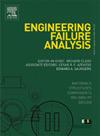热循环载荷下的疲劳断裂行为:实验方法、物理规律和损伤机制
IF 5.7
2区 工程技术
Q1 ENGINEERING, MECHANICAL
引用次数: 0
摘要
热疲劳和蠕变-热疲劳是热循环载荷作用下两种典型的疲劳断裂行为。本研究主要从三个方面展开。i.实验方法。提出了一种适用于带孔薄壁结构的热循环试验方法,并设计了带孔的管状试件。通过对比不同孔型的试验结果,发现锥形孔型试样在裂纹扩展和观察方面表现最好。2。物理规律。实验以温度范围、平均温度和高温保温时间为控制变量。对这些变量的影响模式进行了实证分析。结果表明,温度范围和高温保温时间是加速裂纹扩展的主要因素。平均温度的升高降低了疲劳寿命,但影响相对较弱。3。损伤机制。进行了显微组织观察和元素分析,总结了两种行为的损伤机理。热疲劳裂纹的萌生和扩展主要受疲劳行为支配,穿晶断裂是主要的损伤模式。蠕变-热疲劳裂纹萌生仍然是由疲劳行为主导的。然而,裂纹扩展受蠕变、疲劳和氧化的共同作用驱动,导致沿晶断裂为主要损伤模式。本文章由计算机程序翻译,如有差异,请以英文原文为准。
Fatigue fracture behavior under thermal cyclic loads: Experimental methods, physical regularities, and damage mechanisms
Thermal fatigue and creep-thermal fatigue are two typical fatigue fracture behaviors under thermal cyclic loads. This study focuses on three aspects. i. Experimental methods. A thermal cyclic experimental method suitable for thin-walled structures with holes was developed, and a tubular specimen with test holes was designed. By comparing different test hole configurations, it was found that the conical hole specimen shows the best performance in both crack growth and observation. ii. Physical regularities. Experiments were conducted with temperature range, mean temperature, and high-temperature hold time as the control variables. The influence patterns of these variables were empirically explained. The data demonstrated that the temperature range and high-temperature hold time are the main factors accelerating crack propagation. The increase in mean temperature reduced the fatigue life, but the effect was relatively weak. iii. Damage mechanisms. Microstructural observation and elemental analysis were conducted, and the damage mechanisms for both behaviors were summarized. The initiation and propagation of thermal fatigue cracks are primarily governed by fatigue behavior, with transgranular fracture as the dominant damage mode. Crack initiation in creep-thermal fatigue is still dominated by fatigue behavior. However, crack propagation is driven by the combined effects of creep, fatigue, and oxidation, resulting in intergranular fracture as the primary damage mode.
求助全文
通过发布文献求助,成功后即可免费获取论文全文。
去求助
来源期刊

Engineering Failure Analysis
工程技术-材料科学:表征与测试
CiteScore
7.70
自引率
20.00%
发文量
956
审稿时长
47 days
期刊介绍:
Engineering Failure Analysis publishes research papers describing the analysis of engineering failures and related studies.
Papers relating to the structure, properties and behaviour of engineering materials are encouraged, particularly those which also involve the detailed application of materials parameters to problems in engineering structures, components and design. In addition to the area of materials engineering, the interacting fields of mechanical, manufacturing, aeronautical, civil, chemical, corrosion and design engineering are considered relevant. Activity should be directed at analysing engineering failures and carrying out research to help reduce the incidences of failures and to extend the operating horizons of engineering materials.
Emphasis is placed on the mechanical properties of materials and their behaviour when influenced by structure, process and environment. Metallic, polymeric, ceramic and natural materials are all included and the application of these materials to real engineering situations should be emphasised. The use of a case-study based approach is also encouraged.
Engineering Failure Analysis provides essential reference material and critical feedback into the design process thereby contributing to the prevention of engineering failures in the future. All submissions will be subject to peer review from leading experts in the field.
 求助内容:
求助内容: 应助结果提醒方式:
应助结果提醒方式:


